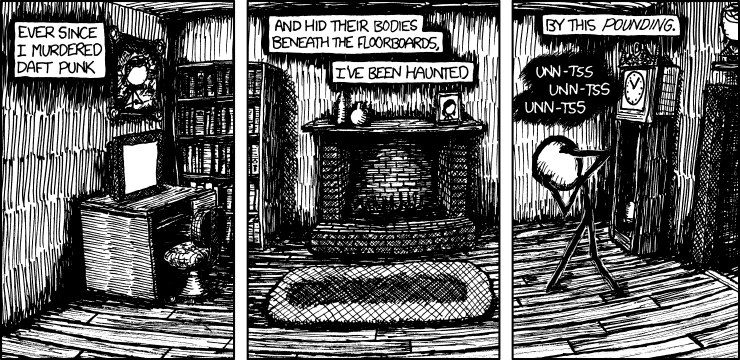ENGL Group 1
*Professor, my apologies for my absence this afternoon, I was feeling pretty sick. I took the opportunity to play catch-up on my assignments now that I know how to navigate the site.*
Feb. 1-3 God’s Man / 1st Readers
In our class discussion, it was speculated that the Mistress’s brand was a metaphor for her obsession with wealth and status. I, however, had initially taken it to be marking her as, literally, a whore. The deal she had made with the portly man earlier had seemed to me very much like a business transaction, and I’d read it as he had bought the artist an ‘escort’, so to speak.
Another interesting thing I’d noticed artistically was that the scene in which the mistress’s true intent is revealed has some strikingly similar images to when Death reveals his true face. Both revelations occur as the artist has set up his canvas and just began to paint; the face he makes upon witnessing Death is identical to when he finds his harlot in the arms of a sailor — black and haunting. The slumping pose he takes as he falls off the cliff at the end is also remarkably similar to the morose stance he takes after finding the Mistress cozying up to a police officer.
Feb 8-10 Batman / No Task
Feb 15-17 Nat Turner / Weekly Roundup
The moment I chose to highlight in Nat Turner was the tossing of the little baby to the shark. Upon first reading, I found it to be atrocious. I’ve always been one to value the sanctity of life, regardless of the current quality of life. To end a life prematurely ensures that that life has no chance to improve; it robs one of all potential possibilities for the good the future might hold, and asserts that the life is so unpleasant it’s not worth sustaining. I was initially unable to relate to the scene in any way; the idea that life could hold so little joy was a baffling concept to me. It began to illuminate to me the plight of the slaves — for one to believe so strongly that the child was better off dead certainly speaks volumes of the quality of their living conditions. It isn’t hard to conceive that someone with this hopeless a view of their life would go to any lengths to change it, including bloody revolution.
Feb 22-24 We3 / Searchers
http://en.wikipedia.org/wiki/Road_Rovers
I know I mentioned this in class, but after rereading We3 I still can’t help but be reminded of the 90’s cartoon Road Rovers. There are some fascinating parallels, despite the disparate intended audiences. Both include anthropomorphized animals in robotic suits, used by humans for the benefit of mankind. (which is in itself a bit ironic) The animals of each are capable of speaking English (the proficiency thereof differs between the two) The Rovers report to a scientist known as “The Master,” while the We3 gang report to scientists they refer to as “Boss.”
When not engaged in crime fighting, the Rovers return to their respective homes and their respective masters. Despite the fact these animals are fully sentient, capable of communication, and possessing superhuman abilities, they are still owned by humans. We3 also perpetuates this notion to some degree, implying in its ending that the animals are home once they ‘belong’ to a human provider.
Obviously the tones of the novel and those of the television show are vastly different; after all, Road Rovers was intended for children. It doesn’t attempt to delve deep into the effects of human alterations on nature, it simply seeks to entertain. The question of why such advanced animals seem to inherently crave human dominance, however, is prevalent in each. Perhaps it’s a commentary on the extent of the domestication of our modern day pets? Loyal to a fault.
